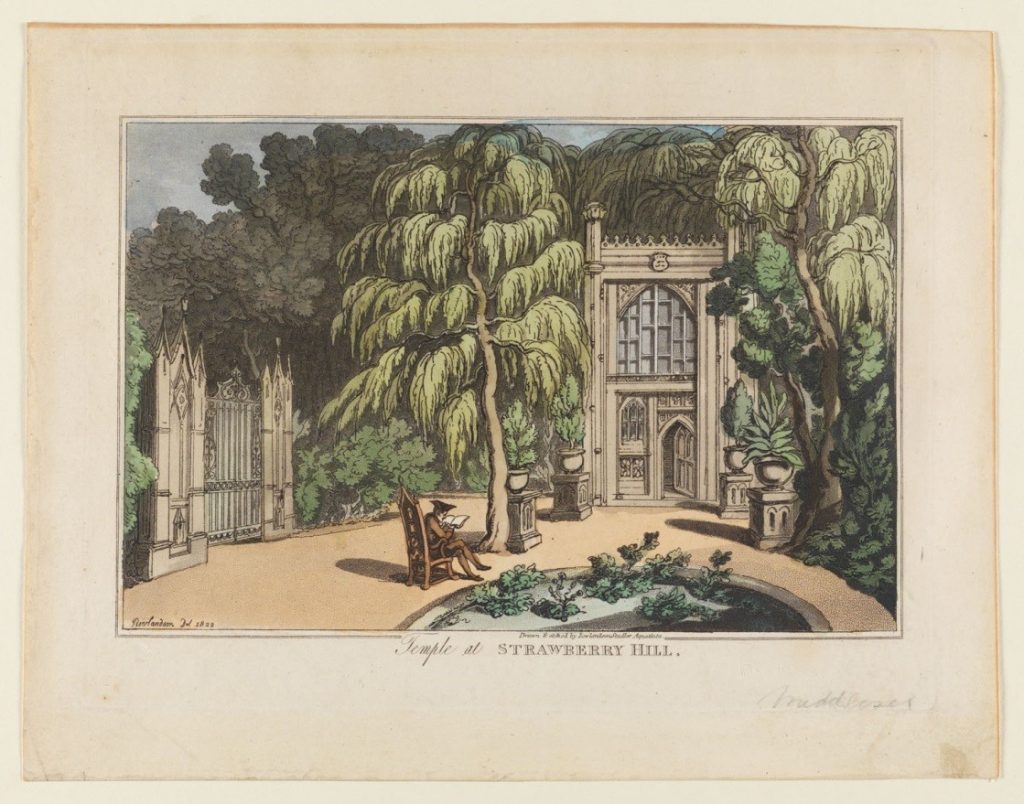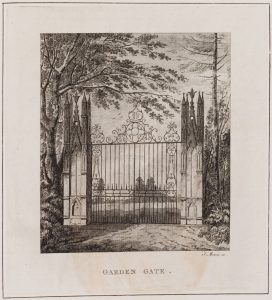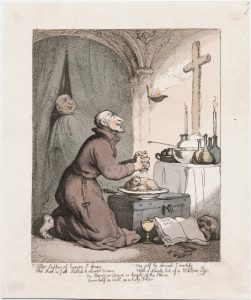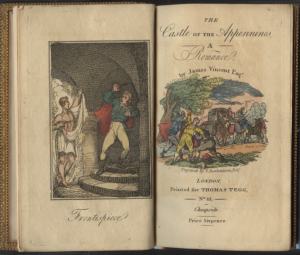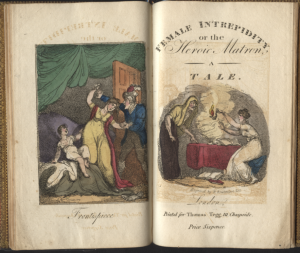22. Mortarboarding Horace Walpole – or Who moved the Gates?
By Nicholas J.S. Knowles, Independent Scholar
An amusing little homage to Horace Walpole as the indubitable high priest of the picturesque imagination can be found in the Lewis Walpole library in the form of a print, The Temple at Strawberry Hill, depicting a solitary capped and gowned scholar seated in the garden, absorbed in reading a book (Figure 1).
The Lewis Walpole Library impression, signed in the plate Rowlandson del 1822 and lettered drawn & etched by Rowlandson, Stadler aquatinta [i] is one of seventeen plates from Thomas Rowlandson’s Sketches from Nature, a collection of views of beauty spots in England, mostly in the West Country but including several taken along the Thames, that make up one of Rowlandson’s most engaging exercises in the picturesque. The series was first published in parts in 1809 by Thomas Tegg [ii]; an advertisement in Jacksons Oxford Journal for 23 Sept 1809 [iii] tells us: “Rowlandsons Sketch book / or, Choice Views from Nature. This day is published in Royal 4to. Containing four beautiful Views from drawings, made on the spot by T.Rowlandson. Esq price in colours to imitate drawings, 2s.6d. No 1. (to be continued every fortnight) The whole intended to assist the young artist, in the various branches of this delightful and fascinating science. All the prints will be etched by T.Rowlandson Esq. from original drawings, by himself, during a tour made in various counties of England in the summers of the years 1803-4-5-6-7 and 8.”
Rowlandson’s frequent presence in the vicinity of the upper Thames as he made his scenic tours is borne out by numerous (enough for a whole exhibition [iv]) surviving drawings of the area from the period, including several relating to Strawberry Hill and one of which, the well known North Entrance of Strawberry Hill, is also in the LWL collection. Whether designing The Temple at Strawberry Hill print actually involved a
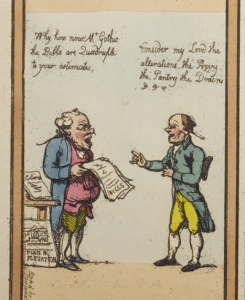
Figure 3 Fragment from sheet 14 of
Grotesque Borders for Rooms and Halls, Thomas Rowlandson Collection (GC112), Graphic Arts Collection, Department of Rare Books and Special Collections, Princeton University Library.
visit to Strawberry Hill at all by Rowlandson is moot, as discussion in this blogpost will show, but the appearance of the print in the same year as the first appearance of Rowlandson & Combe’s bestselling parody, Dr Syntax in search of the Picturesque (first published in parts in Ackermann’s Poetical Magazine), is a definite and affectionate nod to Walpole as the figurehead of the picturesque tradition and underlines of his continuing aesthetic reputation as the progenitor of Gothicism after his death in 1797.
An earlier droll comment by Rowlandson on the raging fashion for the Gothick can be found in one of the twenty-four sheets of Ackermann’s Grotesque Borders for Rooms and halls) (Figure 3), a series of comic friezes intended for decorating rooms, full of topical jokes and allusions [v].
The Gothick revival continued apace in the early 1800’s with William Porden’s extravagantly gothic Eaton Hall (extravagantly built at a cost of over £100,000 between 1803 and 1812 for the 2nd Earl Grosvenor), which was even to be visited by Doctor Syntax himself in a sequel; Dr Syntax’s Second Tour in Search of Consolation (1820). Rowlandson depicts the Reverend Doctor in one of Eaton Hall’s ornate chambers, engaged in a dialogue with his guide on the relative merits of the gothic and the classical styles. Syntax proves to be a good Walpolean disciple, advocating Gothic as the appropriate style for the stately homes of old families, in words that assert its chivalric connotations and bring Horace himself to mind:
“The new rais’d structure should dispense
The style of old magnificence:
The grandeur of a former age
Should still the wond’ring eye engage,
And the last Heir be proud to raise
A mansion as of former days.
…
The last successor claims the praise,
For virtue in these later days,
And walls bedeck’d with traceries;
Windows with rainbow colour’s bright,
With many a fancied symbol dight;
And when he views the turret rise
In bold irregularities;
He feels what no Corinthian pile
Would tell, though of the richest style,
That warriors, statesmen, learned sages,
Had borne his name in former ages,
While he, by ev’ry virtue known,
Does honour to it in his own.” [vi]
In the Temple at Strawberry Hill print, Rowlandson upholds the fictionalising, idealising Walpolean fancy; he shows two of the sights of Strawberry Hill, the ‘Chapel in the Woods’ (Figure 8) and the ‘Garden Gate’ (now lost), which in reality were some distance apart, placed in artificial but harmonious proximity, adds a high-backed gothic chair from Walpole’s collection; and furthermore inserts a young hermit-scholar lost in sublime contemplation – surely intended to be read as a teasing reference to Horace Walpole himself as the genius loci – and who also serves neatly to place the viewer in the picture as well. That the slight figure is intended for Walpole is hinted by the characteristic cross legged pose, seen in the 1750’s drawing of Horace Walpole in his Library by Johann Heinrich Müntz (Figure 4).
A likely basis for the print, in reverse and with some small variations, is a drawing by Rowlandson of the same scene, now in the Courtauld Institute in London, (Figure 5) [vii].
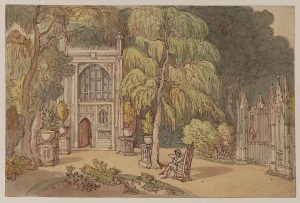
Figure 5 Garden and entrance to a Neo-Gothic house – Strawberry Hill, © The Samuel Courtauld Trust, The Courtauld Gallery, London.
In the drawing, the similarly posed figure of a reader has not been guyed with a mortarboard and gown, but rather has short, natural hair and the knee stockings of the Müntz portrait. He sits serenely absorbed amidst Rowlandson’s swirling rococo penmanship, the lush vegetation flowing into the gothic ornament. Richard Jeffree suggests the drawing is itself fictional iv; a pastiche based on two prints that are among the illustrations to Walpole’s own guide to Strawberry Hill (for which see the Birthday Blog post #15; Walpole’s Two Chief Copies of his “Description of Strawberry Hill,” Printed there in 1774 and 1784). Firstly, a print etched by John Godfrey after a drawing by William Pars of the tiny ‘temple’, whose design Walpole had based closely on the perpendicular gothic Chantry Chapel in the chancel of Salisbury Cathedral; “The Chapel in the south-west corner of the wood, is built of brick, with a beautiful front of Portland stone, executed by Mr. Gaysere of Westminster, and taken from the tomb of Edmund Audley bishop of Salisbury, in that cathedral” [viii].
Godfrey’s print (Figure 6) shows the same four plants on pedestals flanking the entrance to the chapel that are found in Rowlandson’s versions, as well as the two tall trees with distinctive foliage either side, definitely “hanging down poetical” [ix] and the semi-circular lawn in front.
The second component of Rowlandson’s image, the Garden Gate, was also based on a 13th century tomb, described by Walpole as “The piers of the Garden-gates are of artificial stone, and taken from the tomb of William de Luda bishop of Ely, in that Cathedral” [x] and illustrated in Walpole’s description by a print by Thomas Morris after a drawing by Edward Edwards (Figure 7).
The design for the gates is mentioned originally in a letter by Walpole to Henry Cole in a sally almost as contrived as the artificial stone from which they were to be made: “Imprimis then, here are the directions for Mr Essex for the piers of my gates. Bishop Luda must not be offended at my converting his tomb into a gateway. Many a saint and confessor, I doubt, will be glad soon to be passed through, as it will at least secure his being passed over”[xi]. In the ‘Plan of the Estate’ made about c1790, posted into HW’s extra-illustrated copy of the 1784 Description, the ‘Gothic Gate’ is marked as being located on the southeast boundary, some distance from the chapel. Mainly on the strength of Rowlandson’s drawing, WS Lewis suggests that the gate might have been subsequently moved to a position near the chapel [xii]. However Rowlandson was seldom concerned with exact topographical niceties and it is surely more likely that he transposed it by a stroke of his pen than that Walpole did so with a team of workmen – especially if Rowlandson invented his whole scene from Walpole’s prints in the first place. As can be seen from many other drawings by Rowlandson of known locations, the play of pattern and composition are more important in his depiction of places than precision. This is well illustrated by two very different images of Strawberry Hill by him taken from more or less the same vantage point and shown below in Figure 10. Rowlandson freely takes liberties with the road and building elements to create the movement and composition he wants.
While it is of course also perfectly possible that elements of Rowlandson’s sketch of The Temple were actually drawn from life, the similarity of various aspects of the design, in particular, the façade, the window tracery, the half open door, and the curious patterning of the foliage, support the idea that it is based on prints in Walpole’s Description rather than being taken direct [xiii]. This would be entirely unsurprising – there are numerous other examples of Rowlandson using another print as the source for a background; for example, for several of the series of twelve comic prints of Oxford and Cambridge that Rowlandson made for Ackerman between 1809 & 1811, he simply copies prints of Oxford Colleges taken from the Oxford Almanack [xiv] and populates them with lively figures cavorting in the foreground. (This is taken to its logical conclusion in Ackermann’s massive Microcosm of London (1808-1810) where Rowlandson provides the figures for over 130 backgrounds provided by Pugin and others).
The scholar figure in The Temple is clearly fanciful; Rowlandson’s other drawings of Strawberry Hill have similarly invented figures appropriate to the spirit to Walpole’s creation. In North Entrance of Strawberry Hill [with Procession], also in the LWL, a procession of nuns and monks are introduced amidst the stream of carriages and pedestrians. Given that Rowlandson’s views on monasticism are very typically represented by prints such as The Holy Friar (1807) or Monastic Fare (Figure 9), just two of a steady output of anti-clerical satirical prints made throughout his life, and monks are almost invariably depicted by him for comic effect, the procession can happily be read as a jeu d’esprit playing along to Walpole’s medieval fantasy. That said, it is not impossible that Rowlandson actually encountered real monks in the vicinity ─ a significant number of refugee monks and nuns from both English Catholic and French orders had fled to England in the previous decade to escape repression, especially after the September massacres of 1792 [xv]. Walpole himself subscribed to a fund for their relief (though “much against my will and practice”) [xvi]. And in the sketch of Strawberry Hill with a Procession of Monks which, by its loose and rapid pen work, of all Rowlandson’s drawings of Strawberry Hill is most suggestive of a drawing actually made on the spot (Figure 10a), there is indeed a band of monks; forming a dejected crocodile trudging up the road on the left. The second view, from the V&A, shows Rowlandson’s carefree editing of the elements to create his own composition.

Figure 10a. [Strawberry Hill With a Procession of Monks]. Private Collection
Image from Lowell Libson 2016. Catalogue entry #24 in Jefferee 1992 iv
![Drawing by Rowlandson [Strawberry Hill from the West]](https://campuspress.yale.edu/walpole300/files/2018/02/Strawberry-Hill-from-the-west-172voak-300x192.png)
Figure 10b. [Strawberry Hill from the West], Victoria & Albert Museum London DYCE.79. Catalogue entry #25 in Jefferee 1992 iv
Figures 10a & b Two views of Strawberry Hill
The drawing of the chapel in the Woodward is not the only drawing by Rowlandson of Strawberry Hill that is almost certainly fictive. Another illustration from Walpole’s Description, a print of the Tribune by Thomas Morris, is highly plausible as the source for Rowlandson’s drawing of Nuns at Prayer in the Tribune at Strawberry Hill (Figure 11) in which a group of pretty young nuns kneel in ardent supplication before an altar flanked by large candlesticks. This should be read in particular as mischievous ─ nuns appear almost invariable with an erotic charge in Rowlandson prints of the period, ranging from the mildly titillating , such as this 1811 Tegg satire of a visit to a nunnery, to the out and out pornographic; such as this illustration to a Fable by La Fontaine, (undated, but probably made between 1800 and 1810). One cannot fault Rowlandson’s Walpolean sensibilities here however, since Walpole himself wrote of the Tribune that he intended “a cabinet, that is to have all the air of a Catholic chapel – bar consecration!” [xvii]

Figure 11b The cabinet at Strawberry Hill, by Edward Edwards, (Lewis Walpole Library), Folio 49 3582 fol.55 .From Horace Walpole’s extra-illustrated copy of A Description of the Villa…at Strawberry-Hill (Strawberry Hill, 1784, fol.55)
Figures 11a & b The Tribune at Strawberry Hill
By rather a biting irony, both Walpole and Rowlandson’s visions of the chapel proved to be truly visionary – in 1923 Strawberry Hill was bought by the Catholic Education Council for use as a Catholic Teacher Training College and the Vincentian fathers subsequently consecrated the Tribune room as a chapel.[xviii] The joke is definitely on Rowlandson. Would this fate have pleased the shade of Walpole one wonders? Certainly he would be delighted to see his “paper buildings” lasting into another age to become a revered ancient monument in their own right, but his enthusiasm for the architecture, ornaments and ‘relicks’ of the old Catholic Church seems to have belied a dislike of its priggishness and of religious enthusiasm in general; “For the Catholic religion, I think it very consumptive. With a little patience, if Whitfleld, Wesley, my lady Huntingdon, and that rogue Madan live, I do not doubt but we shall have something very like it here. And yet I had rather live at the end of a tawdry religion, than at the beginning; which is always more stern and hypocrite”[xix]. Elsewhere his put down of Catholic bigotry and its excesses is mordant: ‘You know I have ever been averse to toleration of an intolerant religion” going on to observe tartly how religions encourage and feed off the conflict they generate “for modes of religion are but graver fashions: nor will anything but contradiction keep fashion up” [xx] The designer of a Catholic closet does not come over as a closet Catholic.
Can other references to Walpole be found in Rowlandson’s work? While antiquaries and connoisseurs, always ancient and invariably grotesque, sporadically feature as the butt of caricatures throughout Rowlandson career – from the Chamber of Taste (1786); to Modern Antiques; (1811) to or The Antiquaries Last Will and Testament (1816) – yet none of the depictions appear particularly slanted at the elegant Walpole.
But there is, apart from the Strawberry Hill drawings and print, one other, slightly surprising place where one can find Rowlandson burning the Walpolean flame, albeit with somewhat fishy oil. The author of the Castle of Otranto and the Mysterious Mother (LWL Birthday Blog #19) , stands of course as progenitor of The Gothic Novel, which, besides its many legitimate literary heirs, Vathek, The Mysteries of Udolpho, The Monk, Frankenstein, etc, also begat an entire bastard genre of cheap and popular ‘tales of sensation’.
The downmarket publisher Thomas Tegg, for whom Rowlandson made over 200 large caricatures between 1807 and 1815 ─and who published the 1809 edition of Sketches from Nature ─ also in the same period published a successful series of inexpensive chap books for the burgeoning mass market for such fare.  Figure 13 Wrapper for Castle of the Appennines with advertisement for Tegg’s New Pamphlets (Author’s Collection)Tegg’s New Pamphlets came loose stitched in a duodecimo paper wrapper; the advertisement printed on the front (Figure 13) lists nineteen such works and shows that at least fourteen of them are gothic or exotic tales (the rest are popular songs – and a book on fortune telling). At least eight of them include frontispieces and title page vignettes etched by the prolific Rowlandson [xxi]. Compared to his illustrations to Smollett or Fielding from the 1790’s they are slight works, but nonetheless helped to carry the thrills of Walpole’s Gothic sensationalism out to a wider audience. Rowlandson enters wholeheartedly into their world of high melodrama and preposterous terror ridden plots of lost heirs, lost parents; imprisoned maidens, decayed noble families, cloisters, ghosts and banditti, choosing lurid scenes and illustrating them vigorously and with exemplary accuracy to their parody-defying text (Figures 14a & b), to make a cracking sixpennyworth of illustrated schlock.
Figure 13 Wrapper for Castle of the Appennines with advertisement for Tegg’s New Pamphlets (Author’s Collection)Tegg’s New Pamphlets came loose stitched in a duodecimo paper wrapper; the advertisement printed on the front (Figure 13) lists nineteen such works and shows that at least fourteen of them are gothic or exotic tales (the rest are popular songs – and a book on fortune telling). At least eight of them include frontispieces and title page vignettes etched by the prolific Rowlandson [xxi]. Compared to his illustrations to Smollett or Fielding from the 1790’s they are slight works, but nonetheless helped to carry the thrills of Walpole’s Gothic sensationalism out to a wider audience. Rowlandson enters wholeheartedly into their world of high melodrama and preposterous terror ridden plots of lost heirs, lost parents; imprisoned maidens, decayed noble families, cloisters, ghosts and banditti, choosing lurid scenes and illustrating them vigorously and with exemplary accuracy to their parody-defying text (Figures 14a & b), to make a cracking sixpennyworth of illustrated schlock.
Figure 14a. p14: … the sigh was repeated, when a door opened opposite to that by which he had entered, now was made visible by a gentle bluish light, which shone through the dungeon. Appalled and in anxious expectation, he fixed his eyes on it; it slowly opened and a tall figure enveloped in a travelling cloak entered the vault and walked with solemn steps to the centre….
“Tell me,” said Alberto, “who thou art, and whither do you lead me?”
The stranger, without answering, slowly unfolded the cloak, and discovered to the astonished Alberto the form of his beloved father. His face was pallid, and wore the yellow hue of the grave; in his side appeared a ghastly wound, from which issued streams of blood; with a mournful smile he surveyed his son, and in hollow accents thus addressed him :-
“Alberto, your savage uncle Cavigni inflicted this wound, having, under a false pretence, decoyed me from the castle. In a cavern near the west end of the forest you will find my remains; till you pay them due honour I can never rest. Your Emily is still in the power of the Murderer; be quick! Rescue her, and revenge me!”
p18: “You have no doubt heard” said she “of your father’s sudden departure from his castle, in consequence of intelligence he received at a late hour of the night. …. For several hours we travelled through the gloom of night, when, as we emerged from a thicket through which we had been passing, the cabriolet was stopped by a band of ruffians, who bore torches in their hands. Petrified with surprise, the Marchese inquired what they wanted, and commanded them to let him proceed without obstruction. Vain were my cries, vain supplication and resistance; the remorseless villains dragged the Marchese from the carriage and plunged their daggers into his body. Horror struck at the agonizing sight, I sank into insensibility, from which I recovered only to the appalling sense of the miseries which surrounded me. ”
Figure 14b. p6: Maud, petrified at the spirit of Judaism which she thought prevailed in the soul of the babe, wildly seized the knife and was going to stab her infant to the heart, when ‘suddenly the door flew open; her husband rushed into the room, and wrenching the knife from the vengeful mother’s hands, at the same time exclaimed, “Is this the careful mother? Heavens! what a sight I have returned to witness!” “Quit your hold !” exclaimed Maud, in a fiend-like voice. p21: When they separated that night Maud endeavoured to read, as she found herself not inclined to sleep. After perusing several pages she happened to raise her eyes, when to her great astonishment, she saw a female form seated opposite her. Maud composedly trimmed the lamp, and then held it up to view her unknown companion. She seemed an emaciated female of the middling size, a long thin nose, which nearly met her chin, a pair of small eyes, which were almost hid under a high forehead; her dress appeared as if she had stripped a coffin of its shroud; in one bony hand she held a crutch, while the other was placed on the table, which displayed long fingers with hideous sharp nails. “Do you forget me, Maud?” said the hag…”
Figures 14a & b Gothic chap books illustrations by Rowlandson with relevant excerpts
Rowlandson’s drawings of Strawberry Hill, together with the tales of sensation, show a playful engagement with Walpole’s visual and aesthetic legacy. The fanciful invention of both Walpole and Rowlandson is celebrated par excellence in The Temple at Strawberry Hill, a print that still invites the modern reader, even as it would have the 18 viewer, a gripping gothic novel in hand, to contemplate Walpole’s beautiful fictions of an imaginary past ─ with or without their tongue in cheek.
_____________________________________
[i] There are three separate impressions of the Temple at Strawberry Hill at Yale, all from the 1822 edition; a second detached copy is in the Beinecke Library Francis Harvey Album https://brbl-dl.library.yale.edu/vufind/Record/3958773. The Yale Center for British Art has a full set of Sketches from Nature. [ND497.R78 S54 1822+ Oversize]. The 1822 edition was originally issued in a wrapper with a title page in letterpress – Yale also has a very rare surviving example of the wrapper label, found in volume 14 of Frances Harvey album along with the title page. (Figure 2)
[ii] A plain impression of the first state of the plate from my own collection shows a date of 1809 in the plate and Tegg’s imprint additionally below; the removal of the imprint in the later impressions implies a different publisher for the 1822 edition. Some of the copper printing plates for Sketches from Nature may have been owned by Rowlandson himself – one of them is listed by name in lot 449 of the catalogue for the 1828 Sotheby sale of Rowlandson’s studio & collection and survives to this day.
[iii] Payne, Matthew & Payne, James Regarding Thomas Rowlandson Hogarth Press, London, 2012.
[iv] Jeffree, Richard; Mr Rowlandson’s Richmond. Thomas Rowlandson’s drawings of Richmond upon Thames, Museum Of Richmond 1992.
[v] Detail from the copy in Princeton University Library [GA 2014.00795]
[vi] Combe, William The second tour of Dr. Syntax in search of Consolation : a poem . Ackermann, London 1820.
[vii] Witt, bequest; D.1952.RW.3600. Also illustrated #143 p207 in John Hayes, Rowlandson Watercolours and Drawings, London 1972. Hayes dates the drawing as c1815 but the 1809 print would necessarily place it earlier. A second version of the drawing in the Art Institute of Chicago is probably not by Rowlandson; for example, the trees do not “hang poetic” enough for a Rowlandson.
[viii] Walpole, Horace. A description of the villa of Horace Walpole, youngest son of Sir Robert Walpole Earl of Orford at Strawberry-Hill, near Twickenham with an inventory of the furniture, pictures, curiosities. Strawberry Hill, 1774.
[ix] 2. Horace Walpole’s Correspondence, Yale Edition: To BENTLEY, 19 December 1753 (Vol35 p157): “Walpole telling him [Mr Ashe , a nurseryman at Twickenham; he had served Pope] he would have his trees planted irregularly, he said, ‘Yes, Sir, I understand: you would have them hang down somewhat poetical’.”
[x] P.G. Lindley: The Tomb of William de Luda: An Architectural Model at Ely Cathedral. Proceedings of the Cambridge Antiquarian Society. Volume: 73 (1984)
[xi] HWC: To COLE, 15 July 1769 (Vol1 p178)
[xii] Ibid: The footnote on i.p178 of the Yale edition takes the Rowlandson drawing as evidence that the gate was subsequently moved to the chapel.
[xiii] On the 24th day of the 1842 sale of the Strawberry Hill contents, Lot 85 under ‘The Chapel in the Grounds’ is described as “A very fine ancient Stained Glass Window, in Seventeen Compartments”. The window depicted in both Parr and Rowlandson’s prints, which has distinctive asymmetric compartments, was presumably replaced after the sale with what we see now. However both Parr and Rowlandson’s prints show twenty three compartments rather than the seventeen described in the catalogue, consistent with Rowlandsons having made a copy of the print rather than looking at the real window.
[xiv] Petter, Helen Mary. The Oxford Almanacks OUP 1974.
[xv] Moutray, Tonya J. –Refugee Nuns, the French Revolution, and British Literature and Culture, Routledge Abingdon 2016
[xvi] HWC: To HANNAH MORE, 23 March 1793. (Vol31 p383)
[xvii] HWC: To MANN, 8 July 1759 (Vol21 p306)Letter CCXXXVIII July 8 1759 p400 Letters of Horace Walpole, Earl of Orford to Sir Horace Man, Vol 2, Edited by Lord Dover, Dearborn New York 1833
[xviii] Young, Robert A History of Roman Catholicism in Strawberry Hill. The newsletter of the Strawberry Hill Residents’ Association. December 2010 in Bulletin no 144.
[xix] HWC: To COLE 19 December 1767 (Vol1 p124)
[xxi] HWC: To MANN, 8 November 1784 (Vol 25 p541)
[xx1] Gothic and exotic chapbooks for Tegg illustrated by Rowlandson include The Irish Assassin, The Castle of the Black Isles, Female Intrepidity, The School For Friends, The Iron Chest, The History of the Young King of the Black Islands, Sindbad The Sailor, The History of the Nourreddin, The history of Agib. Another chapbook The Complete Fortune Teller, uses an image by Rowlandson recycled by Tegg in a chapbook edition of Breslaw’s last Legacy, a book of magic tricks. A different hand (probably George Cruikshank and others) illustrated other Tegg Pamphlet titles named on the advertisement, viz: The foundling of the Lake, Vancenza, The Enchanted Ring, The Daemon of Venice, The Fatal Vows, The Solemn Warning, Itanoka the Noble Minded Negro.

